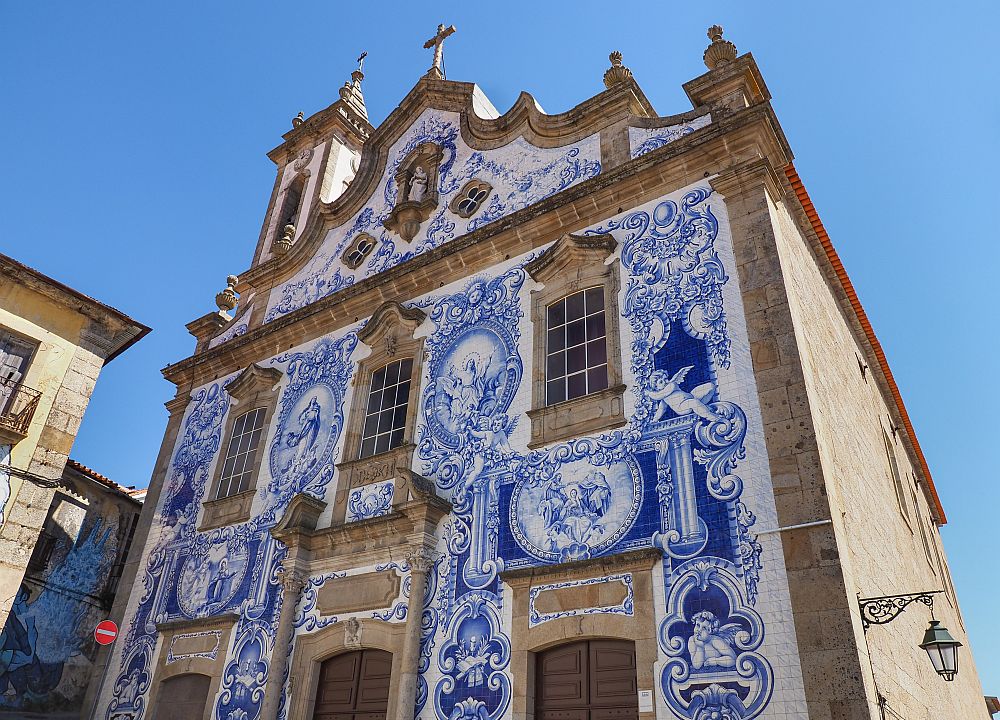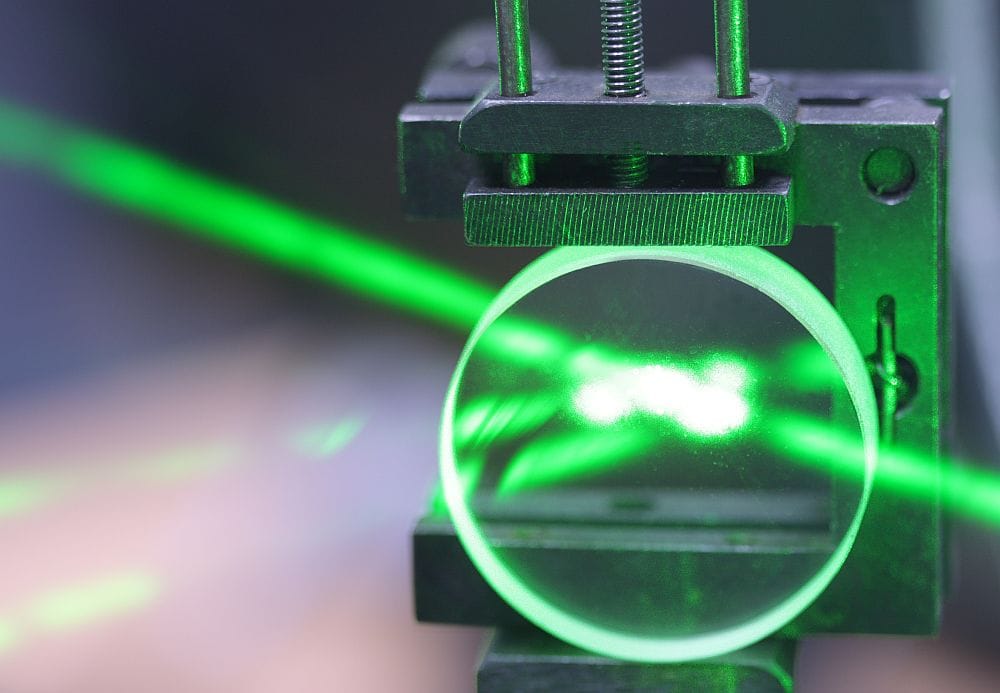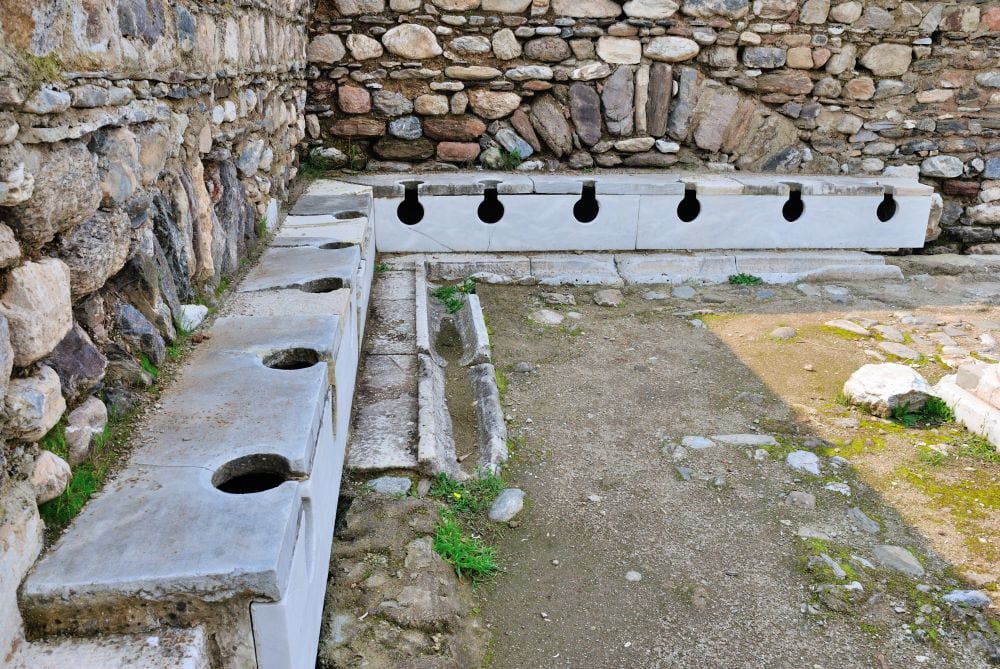
[Image above] Sainte-Chapelle in Paris, France, houses the largest collection of 13th-century stained glass in the world. Done in shades of red and blue, the windows contain 1,130 illustrations of biblical figures. Credit: GruntXIII, Wikimedia Commons (CC BY-SA 4.0)
Anyone who visits a historic church in the Gothic or Gothic Revival style will most likely be blessed with the sight of beautiful stained-glass windows. I experienced this sight for myself when visiting the First Congregational Church/United Church of Christ in downtown Columbus, Ohio.
The church, dedicated in 1931, is a national and Columbus historic landmark. It has a total of 23 stained-glass windows in a variety of styles; the earliest are based on European Medieval designs from the 13th and 14th centuries. The 12 windows of the Creation Series were installed between 1976 and 1983 and are mostly of an abstract Munich style.

The First Congregational Church/United Church of Christ in downtown Columbus, Ohio, and one of its stained-glass windows. Credits: (left) Dr Bob Hall, Flickr (CC BY-SA 2.0); (right) Laurel Sheppard
The awe that I felt when viewing these windows is best summarized by art historian Virginia Chieffo Raguin, who so eloquently wrote in her book Stained Glass: From Its Origins to the Present,
“The art of stained glass …creates architectural planes that permit illumination while transforming the experience of general light to one specific and meaningful to the purpose of a building.”
–Virginia Chieffo Raguin
When explained this way, stained glass is to architecture as poetry is to writing: it is the category of composition that gives viewers a different and deeper appreciation for things compared to other genres.
With April being National Poetry Month, we have arranged a special three-part series on stained glass that will publish every other Tuesday throughout the month of April.
The first part, which you are reading now, overviews the techniques used to create stained glass. The second part, which publishes April 16, details the rise and fall of stained-glass windows between the 11th and 16th centuries. The third part, which publishes April 30, describes the revival of stained-glass windows in the 19th and 20th centuries and discusses its use today.
Though the tradition of creating grand stained-glass windows is less common than it was before, the artform remains an important part of our culture today. I am excited to bring the history of stained glass to light.
Capturing the rainbow: How color is added to stained glass
Before diving into the different materials and processes used to create stained glass, we must first address a somewhat surprising fact: the elaborate stained-glass windows seen in cathedrals are considered a form of painting.
To understand why, we must learn about the multistep fabrication process, as described on the website of United Kingdom charity Heritage Crafts. To create basic stained-glass windows, metal oxides are added to the initial glass melt to imbue it with different colors. When cooled, the colored glass panels are bound together, traditionally with lead strips called “cames,” thereby creating a simple, multicolored rectangular array.

Professional stained-glass artist Derek Hunt refers to a predetermined design as he paints the individual glass pieces. Credit: Derek Hunt Artist, YouTube
To create stained-glass windows with more detailed and elaborate scenes, the colored glass panels are cut into individual pieces based on a predetermined design. Then, the panels are coated with a special paint and fired, which fuses the paint to the glass and gives it additional colors. These painted pieces are then bound together to create decorative windows.
Materials and processes for creating stained-glass windows in the 12th century
Perhaps the oldest existing manuscript describing the production of stained glass is On Divers Arts (Schedula Diversarum Atrium), written by the 12th-century German monk Theophilus. Before Theophilus, manuscripts on the arts came from scholars and philosophers who stood outside the actual profession. Theophilus, however, was a practicing artist.
Theophilus recommended burning beech twigs in an earthen pot to obtain a potassium-rich substance termed “pot ash,” from which the modern term “potash” is derived. This ash was combined with river sand and melted at extremely high temperatures to produce a vitreous paste.
Oxides of iron and manganese contained in the pot ashes created various colors in the fired glass, including red, yellow, brown, and purple. The person firing the mixture needed to understand how changes in furnace conditions affected the colors. Sometimes they would add cobalt and copper to the vitreous paste to obtain blue and red glass, respectively.
After the glass was cooled, it was cut into pieces using a hot iron rod, which caused the glass to snap apart when drawn along the moistened surface.
Paint used in the 12th century was made from a low-firing glass flux, such as potash, and opaque metallic oxides in powder form; these powders were mixed with water, vinegar, or oil. Alternatively, instead of paint, sometimes different colored panels were layered on top of each other to create new color combinations.
To bind the pieces of colored glass together, lead cames were used due to being malleable, durable, and easily soldered. Originally, the lead cames were cast, but later they were milled. A guide allowed placement of the glass pieces in the correct pattern, followed by soldering at the joints. Like grout for tile, linseed oil putty was used to fill the space between the glass and lead cames.
The following video, though much more recent, describes the centuries-old steps typically used.

Credit: Victoria and Albert Museum, YouTube
New and evolving methods for coloring stained glass
In his 1922 book, The Art of Stained and Painted Glass, Swiss artist and craftsman Alfred Werck divides the development of stained glass into three periods:
800–1350. Brown enamel. Nickel was part of the glass composition, causing a brown shade. Rich colors were developed when nickel was eliminated. Copper was added to produce a green–blue color.
1350–1500. Silver stain. The use of silver resulted in a clear yellow color, which varied in intensity from pale lemon to deep orange. To apply the metal, silver oxide in an opaque medium was coated on the back of the glass and fired. After firing, the opaque medium was removed from the glass to reveal the transparent, yellowish glass.
Another development at this time was flashed glass, which consists of thin films of color placed on top of a clear or tinted base glass. The colored glass can be partly or completely etched away using mechanical or chemical methods, resulting in colorless spots where the colored glass was removed.
During this period, flashed glass mainly featured red, white, black, and yellow colors, which were obtained by applying Grisaille paint and silver stain to the abraded glass. Green and violet flashed glass could also be made. This method allowed for the creation of detailed, multicolored designs without joining multiple glass pieces together with lead cames.
1500–1650. New enamel colors. The discovery of new vitreous enamel colors allowed artists to transfer the style of oil painting onto glass. In 1550, a Parisian glass painter developed iron-red enamel, which was followed by the development of blue, green, and violet enamels in the 16th and 17th centuries. As colored glass became scarce in the 1600s, using enamel to decorate glass became popular. By then, most decorative glass was in the form of small heraldic panels (coats of arms) for city halls and private homes.
US innovations in stained glass: Mid-1800s to present
In the mid-1870s, U.S. artist John La Farge invented a method for creating opalescent stained-glass windows. “Opalescent” refers to glass that has a rolled translucent to semi-translucent milky quality and streaks of color.
La Farge received a patent for this type of glass in 1880, but then U.S. artist and designer Louis Comfort Tiffany improved on his invention by developing the copper foil construction method. Tiffany went on to create lamps and vessels out of opalescent glass, and this decision ended his friendship with La Farge.
During the 1950s, U.S. studios began using new techniques to make stained-glass windows, including the Gemmail and Dalle de Verre methods.
Gemmail, a method developed by French artist Jean Crotti in the 1930s, eliminated the need for lead cames to bind glass panels together. Instead, individual pieces of colored glass were overlapped and glued together with a clear substance.
The popular Dalle de Verre method, also invented in France, sets chunks of glass, frequently chipped at the edges to enhance light refraction, in a concrete or epoxy matrix. The First Presbyterian Church of Stamford in Connecticut, nicknamed the Fish Church for its unusual shape, is one of the first buildings in the U.S. to feature this technique.

Picture from inside the First Presbyterian Church of Stamford. Credit: FluffyCreature, Flickr (CC BY-NC 2.0)
These and other techniques, in addition to new types of glass such as kiln-formed, dichroic, and laminated, improved the structural durability of stained-glass windows. The enhanced mechanical properties allowed stained-glass windows to be used as entire walls, and installations expanded from churches to restaurants, commercial buildings, and banks.
In 2017, kiln-formed glass was combined with traditional stained glass painting techniques to create the Resurrection Window, a grand 94 feet by 37 feet stained-glass window at The United Methodist Church of the Resurrection in Leawood, Kansas. Considered a first for the industry, the challenging project was described in a documentary that premiered in 2023.

The massive Resurrection Window towers over the congregation at The United Methodist Church of the Resurrection. Credit: CBS Sunday Morning, YouTube
With stained-glass windows no longer constrained to traditional sizes, “Today’s architects have to take into account not only the decorative contribution of stained glass but also a host of technical considerations, such as the interior temperature, the load borne by the walls, the scale of the building, and the prevailing building regulations,” writes art historian Xavier Barral i Altet in his book Stained Glass: Masterpieces of the Modern Era.
In the 1980s and 1990s, The American Ceramic Society reported on several developments regarding stained glass in its membership magazine, the Ceramic Bulletin (now called the ACerS Bulletin). For example, the December 1989 issue reported that Michel et Daniel Bataillou 21, a French manufacturer and restorer of stained-glass windows, developed a method called Silovitrail for attaching stained glass to industrial glass sheets. The October 1996 issue reported that U.K.-based Esquire Glass Ltd. developed a new method of manufacturing glass components, including stained glass, for the decorative glass furniture industry.
Today, stained-glass artists are experimenting with new materials, such as resin, acrylic, and even recycled glass. Designers are incorporating stained-glass elements into other functional applications, such as furniture, lighting fixtures, room dividers, and even art installations.

Designed by Javier Senosian, Nautilus House in Naucalpan, Mexico, is a great example of how stained glass is being integrated with modern buildings. Credit: (left) MAHFUZ AHMED, Flickr (CC BY 2.0); (right) James Vaughan, Flickr (CC BY-NC-SA 2.0)
With this understanding of how stained glass is made, we can now turn our attention to the history of stained-glass windows. The early history of stained glass up to the 16th century will be detailed in Part 2 of this series, which publishes April 16 here on CTT.
Further reading
Books
- Stained Glass: From Its Origins to the Present, by Virginia Chieffo Raguin
- The Art of Stained and Painted Glass, by Alfred Werck
- Stained Glass: Masterpieces of the Modern Era, by Xavier Barral i Altet
- Stained Glass in America, by John Gilbert Lloyd
Online resources
- Painting with light: University of Notre Dame class that explores the history, significance, and making of stained glass
- Making the case for artful stained glass
- Varieties of stained glass
We also thank The Stained Glass Association of America for the insightful and educational content featured on its website.
Author
Laurel Sheppard
CTT Categories
- Art & Archaeology
- Education
- Glass


